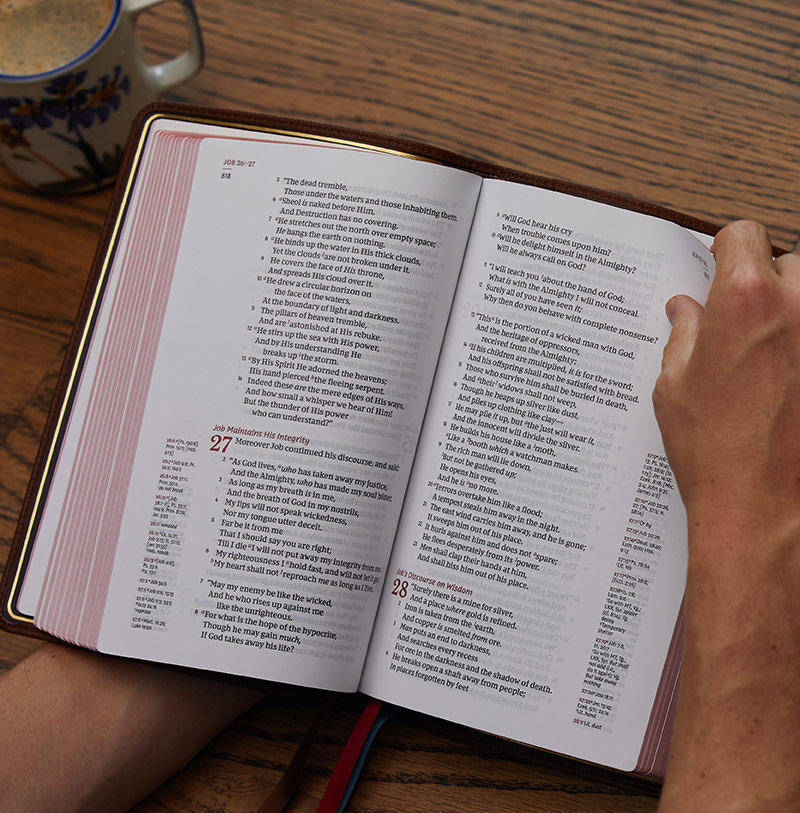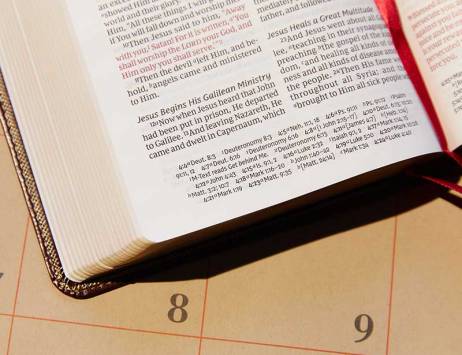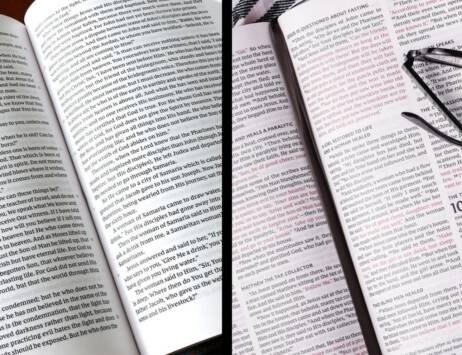The two methods of presented Scripture text on the page are verse-by-verse and paragraph. Both types are available in single and double-column layouts. The two designs are vastly different and they serve different purposes. While many have argued for the exclusive use of one type of layout, we see an advantage in using both. Both designs are valuable, but neither is ideal for every use. The design of the layout can be thought of as a tool designed for a specific purpose.
With the two prominent designs readily available, it can be difficult to know what design you need. In this article, we’ll discuss verse-by-verse and paragraph Bible layouts and see the advantages and disadvantages of each style to help you decide which is best for your needs.
What is a Verse-by-Verse Bible Layout?
A verse-by-verse layout places each verse on a new line. All of the verse numbers are placed on the left of the column, making them easy to find at a glance. This is the traditional layout that has been the standard design for hundreds of years, beginning with the Geneva Bible published in 1560, and is still the standard layout for the KJV.
It does essentially dice up sentences and separate thoughts. This can affect the context, but it doesn’t have to. Paragraphs can still be marked and the text can still be read like a sentence or paragraph. Sections of text can be grouped with headings. We should still read before and after the verse so we understand the surrounding text. Verse-by-verse can be useful if used correctly.
Pros of verse-by-verse layouts
- Verse-by-verse layouts favor navigation. Scanning down the columns is easier and faster than scanning across the columns to find a verse number. This is ideal for preaching, teaching, and following along with someone.
- Verse-by-verse is slower to read than paragraph layouts. Slower reading can force the reader to think more about the text, which can help them see more than they would have seen otherwise.
- It’s easier to focus on a verse at a time, making verse-by-verse ideal for study when using tools such as commentaries, concordances, and references.
- Cross-references and footnotes can be placed at the end of verses. This can save room on the page and makes the references easier to use.
- Preaching and teaching are easier because you can see which verse you’re focusing on.
Cons of verse-by-verse layouts
- It sometimes breaks the text in unnatural places across sentences and thoughts. It’s easy to take Scripture out of context and choose just the pieces we want. Verses are sometimes thought of as individual, stand-alone, statements.
- Verse-by-verse isn’t ideal for casual or devotional reading. It doesn’t look like a book that’s meant to be read. Instead, it conveys the idea of a reference book. Paragraphs have to be indicated by a symbol or a bold verse number. It’s more difficult to read for those used to modern layouts to read. This type of layout doesn’t attract the reader.
What is a Paragraph Bible Layout?
A paragraph layout keeps the sentences together and places the sentences in paragraphs, creating a smooth reading experience, and keeping thoughts together. Verse numbers are then added to the text, making verses easy to identify. This type of layout favors readability and is similar to the layout in William Tyndale’s New Testament first published in 1526.
Paragraph layouts are designed with reading in mind. Sentence and paragraph structure is retained regardless of verse divisions. The structure helps retain the context and makes reading and comprehension easier. This means verse numbers are placed throughout the paragraph rather than in a single file. Verse numbers are more difficult to find, but thoughts are kept together making it easier to see the context.
Pros of paragraph layouts
- Paragraphs are easy to identify. This makes it easier to see when the subject changes. Sentences are not broken in odd places. Context is retained and thoughts are kept together. Scripture is more difficult to take out of context.
- Reading is faster and much smoother because sentences are kept intact. It’s easier to read for longer sessions. It looks like it’s meant to be read. It invites the reader to pick it up enjoy the Word of God. This is ideal for those that are unfamiliar with verse-by-verse layouts.
- It works better for reading in single columns than verse-by-verse because there isn’t awkward white space at the end of sentences.
Cons of paragraph layouts
- Navigation is slower. Rather than scanning down the side of the column, the reader has to also look within the paragraph to find a specific verse. This can take extra time and can be awkward when trying to find a specific verse for public reading.
- Paragraph layouts are not ideal for preaching and teaching. They’re not impossible to preach and teach from, but they can be more difficult than verse-by-verse layouts. Since verse numbers are not lined up to the left of the column it’s more difficult to find your place if you look away from the text.
- It’s harder to focus on a specific verse for study.
- There are fewer options for where to place cross-references and footnotes. They have to be placed outside of the text rather than at the end of verses.
Choose the Bible Right for You
Verse-by-verse and paragraph layouts are both great choices, but the one you need depends on how you plan to use the Bible. It helps to know the advantages and disadvantages of each, so you’ll have a better idea of their strengths and weaknesses and how to use them.
Keep in mind that verse numbers and paragraph divisions are not part of the original text. Verse numbers were added to help us navigate the Scriptures. Paragraphs were added to aid in reading. Also, keep in mind that context matters regardless of the layout.
You’ll find lots of verse-by-verse and paragraph style Bibles in the Thomas Nelson Bibles shop.






4 replies on “Verse-by-Verse vs. Paragraph Style Bible Layouts – Which is Best for You?”
Very interested in obtaining the Thomas Nelson Bible
Please send me information concerning the Bible
I like the verse by verse double column. Also red letter and thumb tab. I haven’t found this in the Thomas Nelson bible yet. I just bought a NKJV Leathersoft red letter large print edition with thumb tabs (5023BLK) I like but it is the paragraph style. I have a Caldwell/Ryrie KJV (by Moody Press) old study bible I really like.
It is double column verse by verse.
Verse by verse only. When a preacher is preaching and you have the Bible in paragraph form you cannot keep up with the preacher and know where he is at in the Bible because you can not find the numbers, because the numbers are the same color. Make the numbers orange green or yellow a color that you can distinguish from the color of the printed words.
Personally, I prefer the Verse by Verse Red Letter Edition for easier purposes of following, reading and studying.